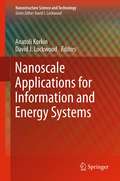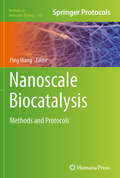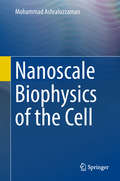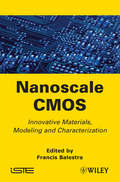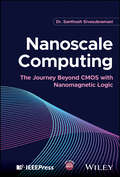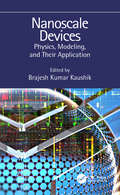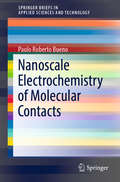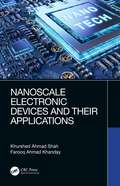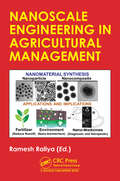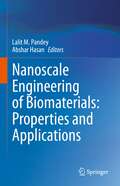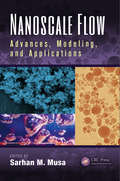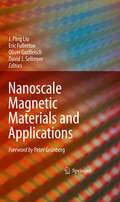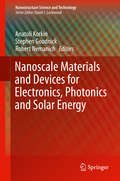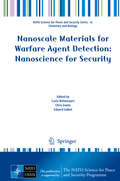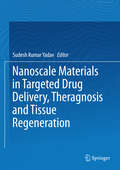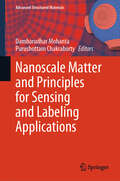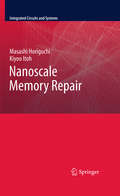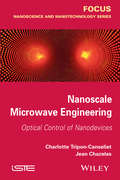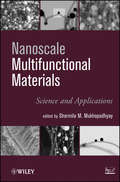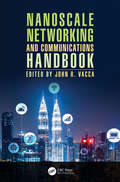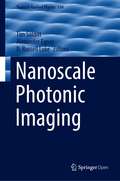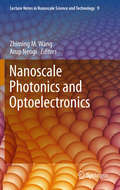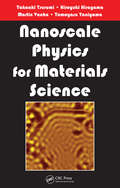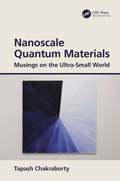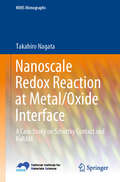- Table View
- List View
Nanoscale Applications for Information and Energy Systems
by Anatoli Korkin David J. LockwoodNanoscale Applications for Information and Energy Systems presents nanotechnology fundamentals and applications in the key research areas of information technology (electronics and photonics) and alternative (solar) energy: plasmonics, photovoltaics, transparent conducting electrodes, silicon electroplating, and resistive switching. The three major technology areas - electronics, photonics, and solar energy - are linked on the basis of similar applications of nanostructured materials in research and development. By bridging the materials physics and chemistry at the atomic scale with device and system design, integration, and performance requirements, tutorial chapters from worldwide leaders in the field provide a coherent picture of theoretical and experimental research efforts and technology development in these highly interdisciplinary areas.
Nanoscale Biocatalysis
by Ping WangNanoscale science and engineering, which deal with size-dependent properties and phenomenon at nanometer scale, are unveiling new mechanisms that scientists must rely on heavily at the present time to achieve efficient and sustainable chemical processing technologies. In Nanoscale Biocatalysis: Methods and Protocols, expert researchers in the field contribute detailed methodologies and procedures that have been developed from recent research in this burgeoning area of nanoscale technology-enabled biocatalysis. The volume opens with concepts in preparing unique and dynamic protein structures for biocatalysis, then moves on to cover methods for preparation of enzyme assembles or complexes that maintain molecular-like Brownian mobility, the development of protein-nanostructure complexes using carbon nanotubes (CNTs) and nanoparticles, as well as methodologies that have great potential for scale-up preparation of nano-structured biocatalysts. Written in the highly successful Methods in Molecular BiologyTM series format, chapters include brief introductions to their respective topics, lists of the necessary materials and reagents, step-by-step, readily reproducible laboratory protocols, and vital tips on troubleshooting and avoiding known pitfalls. Authoritative and cutting-edge, Nanoscale Biocatalysis: Methods and Protocols is an ideal guide to the new wave of development in nearly all the major areas of science and engineering brought about by this fascinating and greatly promising area of study.
Nanoscale Biophysics of the Cell
by Mohammad AshrafuzzamanMacroscopic cellular structures and functions are generally investigated using biological and biochemical approaches. But these methods are no longer adequate when one needs to penetrate deep into the small-scale structures and understand their functions. The cell is found to hold various physical structures, molecular machines, and processes that require physical and mathematical approaches to understand and indeed manipulate them. Disorders in general cellular compartments, perturbations in single molecular structures, drug distribution therein, and target specific drug-binding, etc. are mostly physical phenomena. This book will show how biophysics has revolutionized our way of addressing the science and technology of nanoscale structures of cells, and also describes the potential for manipulating the events that occur in them.
Nanoscale CMOS: Innovative Materials, Modeling and Characterization (Wiley-iste Ser.)
by Francis BalestraThis book provides a comprehensive review of the state-of-the-art in the development of new and innovative materials, and of advanced modeling and characterization methods for nanoscale CMOS devices. Leading global industry bodies including the International Technology Roadmap for Semiconductors (ITRS) have created a forecast of performance improvements that will be delivered in the foreseeable future – in the form of a roadmap that will lead to a substantial enlargement in the number of materials, technologies and device architectures used in CMOS devices. This book addresses the field of materials development, which has been the subject of a major research drive aimed at finding new ways to enhance the performance of semiconductor technologies. It covers three areas that will each have a dramatic impact on the development of future CMOS devices: global and local strained and alternative materials for high speed channels on bulk substrate and insulator; very low access resistance; and various high dielectric constant gate stacks for power scaling. The book also provides information on the most appropriate modeling and simulation methods for electrical properties of advanced MOSFETs, including ballistic transport, gate leakage, atomistic simulation, and compact models for single and multi-gate devices, nanowire and carbon-based FETs. Finally, the book presents an in-depth investigation of the main nanocharacterization techniques that can be used for an accurate determination of transport parameters, interface defects, channel strain as well as RF properties, including capacitance-conductance, improved split C-V, magnetoresistance, charge pumping, low frequency noise, and Raman spectroscopy.
Nanoscale Computing: The Journey Beyond CMOS with Nanomagnetic Logic
by Santhosh SivasubramaniUnderstand the future of computing with this accessible, wide-ranging introduction to a promising field Miniaturization and the emergence of nanotechnology have together constituted the most revolutionary development in recent decades of computing research and innovation. Nanomagnetic computing and logic have allowed engineers and programmers to move beyond the Complementary Metal-Oxide-Semiconductor (CMOS) and their associated methods into a new world of cutting-edge computing technology. Nanoscale Computing offers the first-ever single-authored textbook on this vital subject, introducing the fundamentals of nanoscale computing, their suitability to the traditional limitations of CMOS computing, and their growing number of applications. The result is a key text for students, professionals, and researchers alike. Nanoscale Computing readers will also find: An emphasis on practical applications, both current and future Detailed discussion of topics including nanomagnetic logic, edge computing, and more End of chapter quizzes and additional tutorials to facilitate learning Nanoscale Computing is ideal for researchers and technology experts, as well as graduate and undergraduate students working in computer science, nanotechnology, magnetics, electronics, semiconductors, electron devices, circuits/systems, and multi-interdisciplinary related fields.
Nanoscale Devices: Physics, Modeling, and Their Application
by Brajesh Kumar KaushikThe primary aim of this book is to discuss various aspects of nanoscale device design and their applications including transport mechanism, modeling, and circuit applications. . Provides a platform for modeling and analysis of state-of-the-art devices in nanoscale regime, reviews issues related to optimizing the sub-nanometer device performance and addresses simulation aspect and/or fabrication process of devices Also, includes design problems at the end of each chapter
Nanoscale Electrochemistry of Molecular Contacts (SpringerBriefs in Applied Sciences and Technology)
by Paulo Roberto BuenoThis book discusses the merging of nanoscale electronics and electrochemistry and how this can potentially modernize the way electronic devices are currently engineered or constructed. It introduces the electrochemical capacitance as a fundamental missing concept that solves the puzzle between molecular electronics and electrochemistry at the nanoscale. The electrochemical capacitance, as a fundamental principle, is deduced from first principles quantum mechanics. The text also confirmed that faradaic and non-faradaic processes are only different physical approximations of the same sort of energetic phenomenon.The book comprises three chapters. Chapter one introduces the concepts of chemical capacitance, relaxation resistance, and the quantum resistive-capacitive circuit and demonstrates how these elements are translated to the electrochemistry context. In chapter two, the chemical capacitance, the fundamental concept and missing part of the puzzle that unity electronics and electrochemistry, is deduced from first principles of quantum mechanics. In chapter three, the concepts are practically used in different contexts that include molecular diagnostics, molecular conductance and super-capacitive phenomena is explained using the introduced basic principles.
Nanoscale Electronic Devices and Their Applications
by Khurshed Ahmad Shah Farooq Ahmad KhandayNanoscale Electronic Devices and Their Applications helps readers acquire a thorough understanding of the fundamentals of solids at the nanoscale level in addition to their applications including operation and properties of recent nanoscale devices. This book includes seven chapters that give an overview of electrons in solids, carbon nanotube devices and their applications, doping techniques, construction and operational details of channel-engineered MOSFETs, and spintronic devices and their applications. Structural and operational features of phase-change memory (PCM), memristor, and resistive random-access memory (ReRAM) are also discussed. In addition, some applications of these phase-change devices to logic designs have been presented. Aimed at senior undergraduate students in electrical engineering, micro-electronics engineering, physics, and device physics, this book: Covers a wide area of nanoscale devices while explaining the fundamental physics in these devices Reviews information on CNT two- and three-probe devices, spintronic devices, CNT interconnects, CNT memories, and NDR in CNT FETs Discusses spin-controlled devices and their applications, multi-material devices, and gates in addition to phase-change devices Includes rigorous mathematical derivations of the semiconductor physics Illustrates major concepts thorough discussions and various diagrams
Nanoscale Engineering in Agricultural Management
by Ramesh RaliyaAgriculture plays a vital role in our lives, providing food and economic benefits. Today, it faces severe challenges, due to decreasing arable land, depleting natural resources, changing climate pattern, and yet increasing demand for food. The recent introduction of nanotechnology in agriculture offers sustainable and precise solutions for developing smart agriculture practices and addressing the challenges faced by the ag-sector. Therefore, it is essential to understand this new science from a multidimensional perspective. Experts in the field have contributed in putting together this volume, covering topics like plant growth, protection and management using engineering nanoscale materials. The chapters in the book have been peer-reviewed and selected for publication based on independent reviewers’ reports. The book covers very specific, in-depth, and fundamental and applied aspects of the latest ag-nanotechnology research. It is hoped that each chapter of the book will be very useful for researchers, policy makers, and other audiences from interdisciplinary scientific subjects.
Nanoscale Engineering of Biomaterials: Properties and Applications
by Lalit M. Pandey Abshar HasanThis book provides a comprehensive overview of the latest advances in a wide range of biomaterials for the development of smart and advanced functional materials. It discusses the fundamentals of bio-interfacial interactions and the surface engineering of emerging biomaterials like metals and alloys, polymers, ceramics, and composites/nanocomposites. In turn, the book addresses the latest techniques and approaches to engineering material surfaces/interfaces in, e.g., implants, tissue engineering, drug delivery, antifouling, and dentistry. Lastly, it summarizes various challenges in the design and development of novel biomaterials. Given its scope, it offers a valuable source of information for students, academics, physicians and particularly researchers from diverse disciplines such as material science and engineering, polymer engineering, biotechnology, bioengineering, chemistry, chemical engineering, nanotechnology, and biomedical engineering for various commercial and scientific applications.
Nanoscale Flow: Advances, Modeling, and Applications
by Sarhan M. MusaUnderstanding the physical properties and dynamical behavior of nanochannel flows has been of great interest in recent years and is important for the theoretical study of fluid dynamics and engineering applications in physics, chemistry, medicine, and electronics. The flows inside nanoscale pores are also important due to their highly beneficial drag and heat transfer properties. Nanoscale Flow: Advances, Modeling, and Applications presents the latest research in the multidisciplinary area of nanoscale flow. Featuring contributions from top inventors in industry, academia, and government, this comprehensive book: Highlights the current status of research on nucleate pool boiling heat transfer, flow boiling heat transfer, and critical heat flux (CHF) phenomena of nanofluids Describes two novel fractal models for pool boiling heat transfer of nanofluids, including subcooled pool boiling and nucleate pool boiling Explores thermal conductivity enhancement in nanofluids measured with a hot-wire calorimeter Discusses two-phase laminar mixed convection AL2O3–water nanofluid in an elliptic duct Explains the principles of molecular and omics imaging and spectroscopy techniques for cancer detection Analyzes fluid dynamics modeling of the tumor vasculature and drug transport Studies the properties of nanoscale particles and their impact on diagnosis, therapeutics, and theranostics Provides a brief background and review of medical nanoscale flow applications Contains useful appendices of physical constants, equations, common symbols, mathematical formulas, the periodic table, and more A valuable reference for engineers, scientists, and biologists, Nanoscale Flow: Advances, Modeling, and Applications is also designed for researchers, universities, industrial institutions, and government, giving it broad appeal.
Nanoscale Magnetic Materials and Applications
by Oliver Gutfleisch J. Ping Liu D. J. Sellmyer Eric FullertonNanoscale Magnetic Materials and Applications covers exciting new developments in the field of advanced magnetic materials. Readers will find valuable reviews of the current experimental and theoretical work on novel magnetic structures, nanocomposite magnets, spintronic materials, domain structure and domain-wall motion, in addition to nanoparticles and patterned magnetic recording media. Cutting-edge applications in the field are described by leading experts from academic and industrial communities. These include new devices based on domain wall motion, magnetic sensors derived from both giant and tunneling magnetoresistance, thin film devices in micro-electromechanical systems, and nanoparticle applications in biomedicine. In addition to providing an introduction to the advances in magnetic materials and applications at the nanoscale, this volume also presents emerging materials and phenomena, such as magnetocaloric and ferromagnetic shape memory materials, which motivate future development in this exciting field. Nanoscale Magnetic Materials and Applications also features a foreword written by Peter Grünberg, recipient of the 2007 Nobel Prize in Physics.
Nanoscale Materials and Devices for Electronics, Photonics and Solar Energy
by Anatoli Korkin Stephen Goodnick Robert NemanichThis book presents research dedicated to solving scientific and technological problems in many areas of electronics, photonics and renewable energy. Progress in information and renewable energy technologies requires miniaturization of devices and reduction of costs, energy and material consumption. The latest generation of electronic devices is now approaching nanometer scale dimensions; new materials are being introduced into electronics manufacturing at an unprecedented rate; and alternative technologies to mainstream CMOS are evolving. The low cost of natural energy sources have created economic barriers to the development of alternative and more efficient solar energy systems, fuel cells and batteries. Nanotechnology is widely accepted as a source of potential solutions in securing future progress for information and energy technologies. Nanoscale Materials and Devices for Electronics, Photonics and Solar Energy features chapters that cover the following areas: atomic scale materials design, bio- and molecular electronics, high frequency electronics, fabrication of nanodevices, magnetic materials and spintronics, materials and processes for integrated and subwave optoelectronics, nanoCMOS, new materials for FETs and other devices, nanoelectronics system architecture, nano optics and lasers, non-silicon materials and devices, chemical and biosensors,quantum effects in devices, nano science and technology applications in the development of novel solar energy devices, and fuel cells and batteries.
Nanoscale Materials for Warfare Agent Detection: Nanoscience for Security (NATO Science for Peace and Security Series A: Chemistry and Biology)
by Carla Bittencourt Chris Ewels Eduard LlobetThis book presents a blueprint for researchers in the area of nanotechnology for chemical defense, especially with regard to future research on detection and protection. It addresses the synthesis of complex nanomaterials with potential applications in a broad range of sensing systems. Above all, it discusses novel experimental and theoretical tools for characterizing and modeling nanostructures and their integration in complex systems. The book also includes electronic structure calculations exploring the atomic and quantum mechanical mechanisms behind molecular binding and identification, so as to provide readers with an in-depth understanding of the capabilities and limitations of various nanomaterial approaches. Gathering contributions by scientists with diverse backgrounds, the book offers a wealth of insightful information for all scientists whose work involves material science and its applications in sensing.
Nanoscale Materials in Targeted Drug Delivery, Theragnosis and Tissue Regeneration
by Sudesh Kumar YadavThis book is the first of its kind to offer a comprehensive and up-to-date discussion of the use of nanoscale materials for biomedical applications, with a particular focus on drug delivery, theragnosis and tissue regeneration. It also describes in detail the methods used in the preparation of nanoparticles. Response of nanoparticles in biological systems are also explored. Nanotechnology has led to the advent of a new field, nanomedicine, which focuses on the use of nanomaterials as drug-delivery vehicles to develop highly selective and effective drugs. The combination of molecular imaging and nanotechnology has produced theragnostic nanoparticles, which allow the simultaneous detection and monitoring of diseases. Nanotechnology can also be combined with biomaterials to create scaffolds for tissue regeneration. Further, significant advances have been made in the areas of drug delivery, theragnostic nanoparticles and tissue regeneration materials. Some nanomedicines and tissue regeneration materials are already commercially available, while others are undergoing clinical trials, and promising results have been documented. Despite the rapid advances in nanomedicine, there is a relative dearth of literature on the biomedical applications of nanoscale materials.
Nanoscale Matter and Principles for Sensing and Labeling Applications (Advanced Structured Materials #206)
by Dambarudhar Mohanta Purushottam ChakrabortyThis book is a compilation of carefully chosen chapters that cover the subjects of nanoscale matter, sensing, and labelling applications. It is aimed primarily at scientists and researchers who are already involved in theme-based research or who are just starting their careers. Despite the diverse nature of the topics covered, which include a range of materials in various forms and uses, the emphasis is primarily on sensing and labelling phenomena. The book begins with materials quantification in nanoscale systems by using an innovative technique like “molecular secondary ion mass spectrometry without calibration standards”. Subsequently, the book features an array of materials such as inorganic semiconductor nanoscale particles, carbon dots, rare-earth oxides, polymer nanocomposites, and a few biomaterials, all of which illustrate their functionality and potential for deployment in a wide variety of sensing applications. Although the book delves into the technical aspects of fabrication workouts to some extent, the focus is predominantly on the physical principles, mechanisms, and relevance involved in sensing and labelling applications. The book covers a wide range of topics that leverage the unique properties of nanoscale materials. By carefully selecting appropriate active materials, the authors explore the detection of LPG, hazardous and explosive gases, as well as humidity sensing and hydrogen evolution. It also delves into photo-sensing and persistent photoconductivity by using nanoscale semiconductors, which are used for heavy metal sensing and UV sensing, respectively. The use of metal nanoparticles in various forms is reviewed to address issues related to water contamination, biofilm protection, and food-borne pathogens. The book also discusses surface plasmon resonance, starting with its basic principles and expanding to its relevance in a broader perspective, with a greater focus on applied biosensing. Nanoscale ferrites and magnetic systems are explored with an emphasis on magnetic sensing and actuation. Lastly, the book explores the use of rare-earth-based nanosystems, highlighting persistent luminescence and up/down-converted transitions, which have unprecedented applications in bioimaging and biolabeling. Every effort has been made to strike a balance between the observed phenomena in the emerging areas of sensing applications and suitable theoretical treatments there in.
Nanoscale Memory Repair
by Masashi Horiguchi Kiyoo ItohYield and reliability of memories have degraded with device and voltage scaling in the nano-scale era, due to ever-increasing hard/soft errors and device parameter variations. This book systematically describes these yield and reliability issues in terms of mathematics and engineering, as well as an array of repair techniques, based on the authors' long careers in developing memories and low-voltage CMOS circuits. Nanoscale Memory Repair gives a detailed explanation of the various yield models and calculations, as well as various, practical logic and circuits that are critical for higher yield and reliability.
Nanoscale Microwave Engineering: Optical Control of Nanodevices
by Charlotte Tripon-Canseliet Jean ChazelasThis book targets new trends in microwave engineering by downscaling components and devices for industrial purposes such as miniaturization and function densification, in association with the new approach of activation by a confined optical remote control. It covers the fundamental groundwork of the structure, property, characterization methods and applications of 1D and 2D nanostructures, along with providing the necessary knowledge on atomic structure, how it relates to the material band-structure and how this in turn leads to the amazing properties of these structures. It thus provides new graduates, PhD students and post-doctorates with a resource equipping them with the knowledge to undertake their research.
Nanoscale Multifunctional Materials: Science and Applications
by Sharmila M. MukhopadhyayThis book consolidates various aspects of nanomaterials, highlighting their versatility as well as how the same materials can be used in seemingly diverse applications spanning across disciplines. It captures the multi-disciplinary and multi-functional aspects of nanomaterials in a holistic way. Chapters address the key attributes of nanoscale materials that make them special and desirable as novel materials; functionality that emerges based on these unique attributes; multiple uses of nanomaterials incuding combining properties and materials selection, and then separate chapters devoted to energy, biomedical materials, environmental applications, and chemical engineering applications.
Nanoscale Networking and Communications Handbook
by John VaccaThis comprehensive handbook serves as a professional reference as well as a practitioner's guide to today's most complete and concise view of nanoscale networking and communications. It offers in-depth coverage of theory, technology, and practice as they relate to established technologies and recent advancements. It explores practical solutions to a wide range of nanoscale networking and communications issues. Individual chapters, authored by leading experts in the field, address the immediate and long-term challenges in the authors' respective areas of expertise.
Nanoscale Photonic Imaging (Topics in Applied Physics #134)
by D. Russell Luke Tim Salditt Alexander EgnerThis open access book, edited and authored by a team of world-leading researchers, provides a broad overview of advanced photonic methods for nanoscale visualization, as well as describing a range of fascinating in-depth studies. Introductory chapters cover the most relevant physics and basic methods that young researchers need to master in order to work effectively in the field of nanoscale photonic imaging, from physical first principles, to instrumentation, to mathematical foundations of imaging and data analysis. Subsequent chapters demonstrate how these cutting edge methods are applied to a variety of systems, including complex fluids and biomolecular systems, for visualizing their structure and dynamics, in space and on timescales extending over many orders of magnitude down to the femtosecond range. Progress in nanoscale photonic imaging in Göttingen has been the sum total of more than a decade of work by a wide range of scientists and mathematicians across disciplines, working together in a vibrant collaboration of a kind rarely matched. This volume presents the highlights of their research achievements and serves as a record of the unique and remarkable constellation of contributors, as well as looking ahead at the future prospects in this field. It will serve not only as a useful reference for experienced researchers but also as a valuable point of entry for newcomers.
Nanoscale Photonics and Optoelectronics
by Zhiming M Wang Arup NeogiThe intersection of nanostructured materials with photonics and electronics shows great potential for clinical diagnostics, sensors, ultrafast telecommunication devices, and a new generation of compact and fast computers. Nanophotonics draws upon cross-disciplinary expertise from physics, materials science, chemistry, electrical engineering, biology, and medicine to create novel technologies to meet a variety of challenges. This is the first book to focus on novel materials and techniques relevant to the burgeoning area of nanoscale photonics and optoelectronics, including novel-hybrid materials with multifunctional capabilities and recent advancements in the understanding of optical interactions in nanoscale materials and quantum-confined objects. Leading experts provide a fundamental understanding of photonics and the related science and technology of plasmonics, polaritons, quantum dots for nanophotonics, nanoscale field emitters, near-field optics, nanophotonic architecture, and nanobiophotonic materials.
Nanoscale Physics for Materials Science
by Takaaki Tsurumi Hiroyuki Hirayama Martin Vacha Tomoyasu TaniyamaAlthough there are many books available on the preparation, properties, and characterization of nanomaterials, few provide an interdisciplinary account of the physical phenomena that govern the novel properties of nanomaterials. Addressing this shortfall, Nanoscale Physics for Materials Science covers fundamental cross-disciplinary concepts in mate
Nanoscale Quantum Materials: Musings on the Ultra-Small World
by Tapash ChakrabortyIn the past four decades, there has been growing interest in the exciting new topic of physics in low dimensions. Thousands of original ideas have been proposed in the literature, and some are confirmed experimentally, along with several Nobel prizes which have been awarded in this field. While there are several books available, almost all are technical and accessible only to expert researchers. This book provides an accessible introduction to the field, with less emphasis on technical details. Whilst this book does not provide a traditional history of nano-science, instead it uses simple explanations and case studies as vehicles to explain key discoveries and the importance of them, enabling readers without a background in the area to gain an understanding of some aspects of nanoscale physics. It will be of interest to researchers working in condensed matter physics, in addition to engineers and advanced students in those disciplines. It also remains accessible to ‘physics enthusiasts’ from other academic disciplines, as technical details are contained within boxes and footnotes which can be skipped for a general reading of the book. Features:- Provides an accessible introduction to a technical subject- Contains exciting developments from the cutting-edge science being conducted in the area - Authored by a recognised expert in the field
Nanoscale Redox Reaction at Metal/Oxide Interface: A Case Study on Schottky Contact and ReRAM (NIMS Monographs)
by Takahiro NagataOxide materials are good candidates for replacing Si devices, which are increasingly reaching their performance limits, since the former offer a range of unique properties, due to their composition, design and/or doping techniques. The author introduces a means of selecting oxide materials according to their functions and explains metal/oxide interface physics. As he demonstrates, material development is the key to matching oxide materials to specific practical applications.In this book, the investigation and intentional control of metal/oxide interface structure and electrical properties using data obtained with non-destructive methods such as x-ray photoelectron spectroscopy (XPS) and x-ray reflectometry (XRR) are discussed. Further, it shows how oxide materials can be used to support the development of future functional devices with high-k, ferroelectric, magnetic and optical properties. In closing, it explains optical sensors as an application of metal Schottky contact and metal/oxide resistive random access memory structure.
